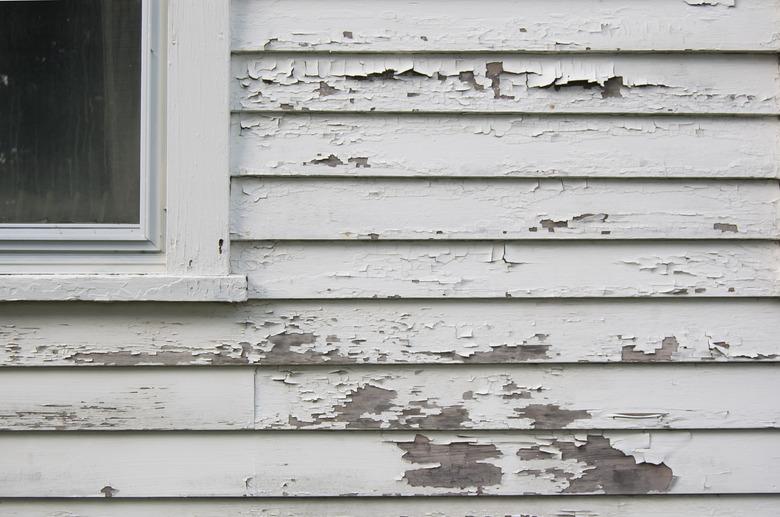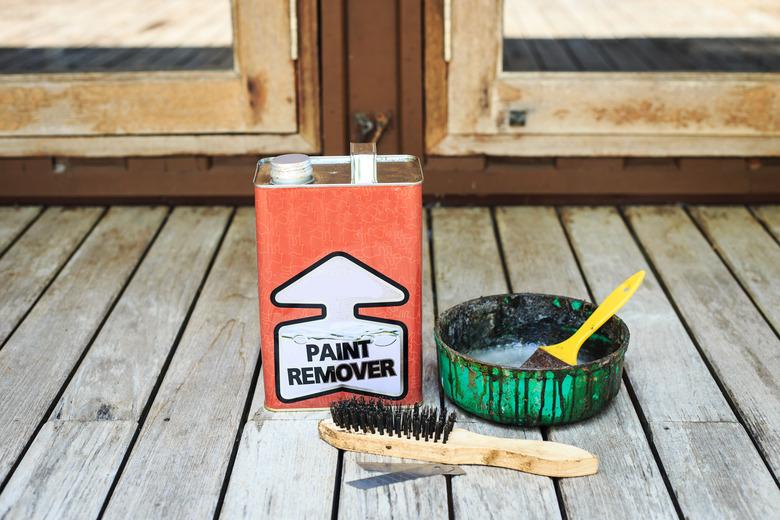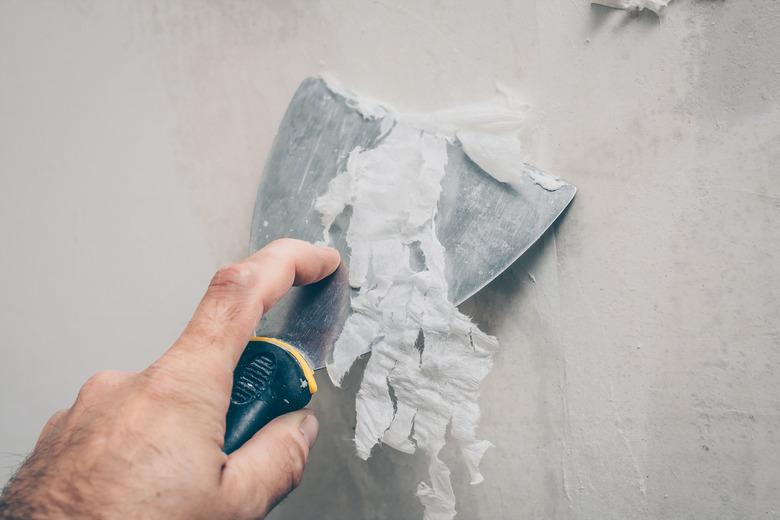3 Ways To Remove Paint From Wood
We may receive a commission on purchases made from links.
A coat of paint looks great on a piece of wood only until it doesn't, which is when it has aged enough to start fading, cracking and peeling. You can bring back the good times with a fresh coat of paint, of course; but it isn't a good idea to paint over cracking and peeling paint, so you should remove the old stuff first. Moreover, if you want to expose the wood and apply a stain or clear finish, the paint definitely has to go. The best method for removing paint depends not only on the paint, but also on the shape of the wood and how accessible it is. Removing paint from the face of a cabinet or a tabletop is a whole different thing than getting it off a wrought-iron fence baluster or the eaves of an old clapboard house.
Check for Lead Before You Start
Check for Lead Before You Start
Lead was a common ingredient in paint prior to 1978, when government regulators, recognizing its toxicity, banned its use in all residential paint products. Any old paint that predates the ban is likely to contain lead, and you don't want to use a paint removal method that creates airborne paint dust or endangers children and pets by littering the surroundings with lead-laden paint chips.
You can check for lead yourself, using a LeadCheck swab available at most building supply outlets. Rub the swab over the painted surface and check the color. If it turns red, the paint contains lead. This method isn't very reliable if the paint itself happens to be pink or red, though, and in that case, it's best to carefully scrape off a teaspoon-sized sample and send it to a lab for testing. You can buy a test kit at the the same building outlet that provides a bag to hold the sample and a pre-addressed envelope. Expect to wait a couple of weeks for the results. A positive result doesn't mean you can't remove the paint, but it limits the methods you can use to do it.
1. Using Chemical Strippers
1. Using Chemical Strippers
Chemical strippers work by softening the paint and loosening its bond to the wood so you can scrape it off. They are a good removal option when lead paint is present. The active ingredient in traditional stripper formulations is methylene chloride, and this highly caustic and toxic chemical is still in use today. It works quickly and effectively, but it produces dangerous fumes and can easily burn skin, so it's no longer the number one recommendation. Among safer alternatives are products containing benzyl alcohol and N-Methyl-2-pyrrolidone (NMP), which is an ingredient in citrus-based strippers. The price you pay for safer stripping formulations is that they work more slowly, and you may need more product to do the job.
The basic procedure for chemical stripping is to spread the product on the painted surface with a paintbrush, wait for the paint to soften and bubble up, then scrape it off with a paint scraper. You may have to wait from 30 minutes to 12 hours before scraping, depending on the product and the condition of the paint. After using a stripper, you should wet down the wood with water to neutralize any residue that remains. Always dispose of the gooey mass of scraped paint as hazardous waste, especially if the paint contains lead.
2.Using a Heat Gun
2.Using a Heat Gun
Another way to safely remove paint that contains lead, as well as any other type of paint, is to heat it with a heat gun, an infrared paint stripper or a steam stripper.
Heat guns are like powerful hair dryers that blast concentrated hot air on the paint, softening it so you can scrape it off. Because it raises the temperature of the surface quickly and dramatically, you have to keep the gun moving to avoid igniting the paint and scorching wood. In a typical procedure, you hold the heat gun on a spot for 10 to 20 seconds, then move it to another spot while you scrape the paint from the one that was just heated.
An infrared stripper works in much the same way, but it won't heat the paint or the wood enough to start a fire, so it's a safer option. The problem with infrared strippers is that they are bulky and not really an option for stripping furniture. They work great on large, flat surfaces, however, such as house siding and exterior trim. The procedure for using one is the same as for using a heat gun.
Steam strippers are heavy-duty paint removal tools used mainly for siding, decks and other exterior surfaces. The temperature of the steam never rises above 212 degrees Fahrenheit. While there's no danger of fire, there could be an issue with moisture saturation of the wood. The steam emulsifies the paint so you can scrape it off, but it may cause warping. Steam stripping is best used on such materials as fiber cement, concrete and metal.
3. Scraping and Sanding
3. Scraping and Sanding
No matter which paint-removal method you use, some scraping and sanding will be involved, and in some cases, you can even skip the chemicals or heat altogether. A belt or pad sander with medium or coarse sandpaper can remove loose, flaking paint from virtually any surface, provided it doesn't have corners too tight for the tool to access. If you need to do detail sanding on a turned piece of wood or a piece of contoured molding, fit a sanding drum to a drill or a rotary tool. Use light pressure when sanding to avoid changing the shape of the wood.
A scraper can also make short work of a flat surface with a coat of loose paint. Scrapers come in various styles, including flat paint scrapers, 5-in-1 tools which have a number of edges and shapes that allow the tool to access corners, and pull scrapers. Flat scrapers excel at removing loose, flaking paint quickly. If the paint you want to remove is still hard and in good condition, a pull scraper is the best tool for scraping it off. Keep a file handy to keep the scraper edge sharp.
Scraping often leaves small bits of paint embedded in the wood grain. You can usually get these out using a solvent, such as paint thinner, lacquer thinner or alcohol. Moisten a rag or an abrasive sponge and scrub to get most of the paint, then follow up with a pad sander to get the rest and smooth down the wood grain.
Scraping and sanding very often go hand-in-hand. After loose paint chips are removed, power- or hand-sanding can be used to "feature" the edges where paint remains, creating a smooth surface for the new coat of paint to adhere to.
Scraping and sanding are not the method to use if you have lead paint. Scraping leaves chips that animals or children can eat, and the sanding dust can be inhaled, causing you to ingest dangerous levels of lead.




